|
And They Brought Forth Gifts
by
Bob Brooke
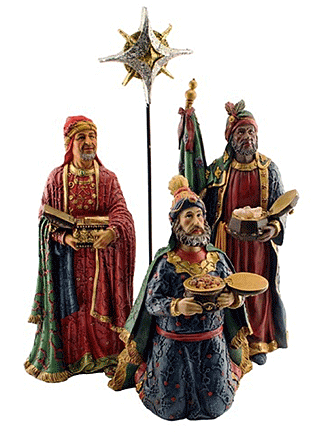 On
a clear starry night in ancient Judea, three men—Patisar, Caspar, and
Melchior— riding camels paused to look at the brightest star in the
heavens. According to the Gospel of Matthew, they had traveled from afar
following this star to the town of Bethlehem in order to pay homage to
the infant Jesus. As was the tradition in those days, they came bearing
gifts of gold, frankincense and myrrh, three very valuable commodities.
And so Christian tradition and thousands of images bear witness. On
a clear starry night in ancient Judea, three men—Patisar, Caspar, and
Melchior— riding camels paused to look at the brightest star in the
heavens. According to the Gospel of Matthew, they had traveled from afar
following this star to the town of Bethlehem in order to pay homage to
the infant Jesus. As was the tradition in those days, they came bearing
gifts of gold, frankincense and myrrh, three very valuable commodities.
And so Christian tradition and thousands of images bear witness.
All three gifts were ordinary offerings and gifts given to a king. Gold
as a valuable, frankincense as a perfume, and myrrh as an anointing oil.
But these gifts also had a spiritual meaning—gold as a symbol of
kingship on Earth, frankincense as a symbol of deity, and myrrh as a
symbol of death. But what is less known about were the containers—called
caskets—in which the men transported their gifts.
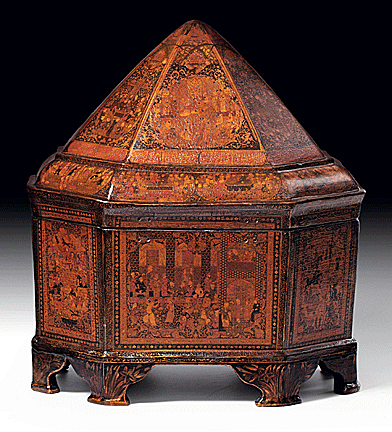 Over
the centuries, caskets—to many people the elaborate boxes in which the
dead are placed to be buried—have taken a variety of forms, from modest
little boxes covered in leather and lined with satin to large jewel
cabinets made for Marie Antoinette. Over
the centuries, caskets—to many people the elaborate boxes in which the
dead are placed to be buried—have taken a variety of forms, from modest
little boxes covered in leather and lined with satin to large jewel
cabinets made for Marie Antoinette.
The actual meaning of the word “casket” is a small ornamental box or
chest for holding jewels, letters, or other valued objects. It comes
from the Old French word cassette, a diminutive form of case.
Artisans crafted caskets of precious materials, such as gold, silver,
and ivory. In ancient East Asia, they often made them of porcelain or
wood covered in silk.
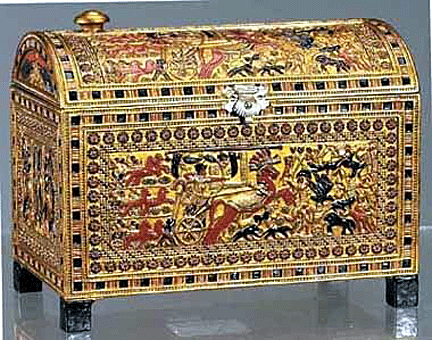 Jewelry
boxes were in common use as early as 5000 BCE in Ancient Egypt since the
majority of Egyptians, male and female, wore jewelry. The Egyptians
preferred material was gold, often encrusted with precious gems and as
such, a secure, yet often well decorated box or casket was required to
keep such items safe. Generally, a casket was smaller than a chest and
could be placed on top of a table. In recent times they are mostly
receptacles for trinkets and jewels, but in earlier periods, Jewelry
boxes were in common use as early as 5000 BCE in Ancient Egypt since the
majority of Egyptians, male and female, wore jewelry. The Egyptians
preferred material was gold, often encrusted with precious gems and as
such, a secure, yet often well decorated box or casket was required to
keep such items safe. Generally, a casket was smaller than a chest and
could be placed on top of a table. In recent times they are mostly
receptacles for trinkets and jewels, but in earlier periods,
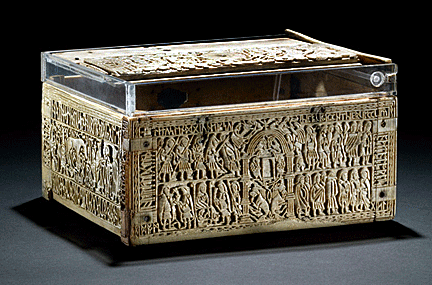 when
other types of container were rarer, and the amount of documents held by
the typical person far fewer, they were used for keeping important
documents and many other purposes. Caskets are often made in precious
materials, such as gold, silver or ivory. when
other types of container were rarer, and the amount of documents held by
the typical person far fewer, they were used for keeping important
documents and many other purposes. Caskets are often made in precious
materials, such as gold, silver or ivory.
The 4th century Brescia Casket, 8th century Franks Casket and 10th-11th
century Veroli Casket are all in elaborately carved ivory, a popular
material for luxury boxes until recent times.
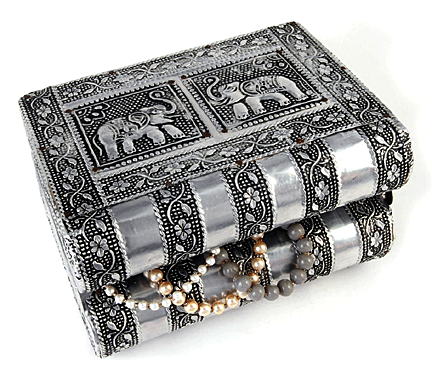 Originally,
jewelry boxes were more similar to treasure chests, hence the term
“jewelry casket” became interchangeable with “jewelry box.” The term
jewelry casket is usually used when referring to a larger box, which
would be considered slightly smaller than a chest, and usually raised on
feet, rather than the base being flat to the surface which it rests on. Originally,
jewelry boxes were more similar to treasure chests, hence the term
“jewelry casket” became interchangeable with “jewelry box.” The term
jewelry casket is usually used when referring to a larger box, which
would be considered slightly smaller than a chest, and usually raised on
feet, rather than the base being flat to the surface which it rests on.
In Rome, jewelry was a status symbol, with only certain ranks permitted
to wear rings for example. Fine brooches were used to secure items of
clothing, and again, jewelry boxes were required for storage purpose.
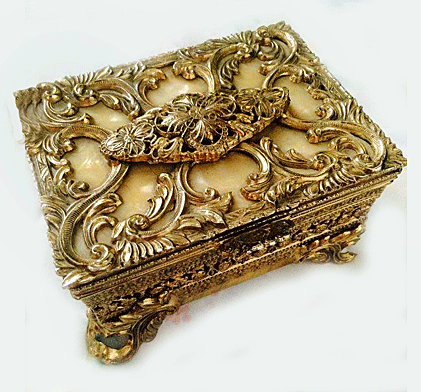 Until
the Victorian era, owning jewelry was a rare luxury, and to have enough
jewelry to need storage for it was a privilege bestowed upon only a few
members of royalty and high society. Until
the Victorian era, owning jewelry was a rare luxury, and to have enough
jewelry to need storage for it was a privilege bestowed upon only a few
members of royalty and high society.
Jewelry boxes, jewelry caskets and trinket boxes have all varied widely
in their appearance over history. Ornate styles with elaborate detail
were initially common, indicating outwardly the value of the items
inside.
<
Back to Antiques Archives
Next Article > |
